Calculus TMA Solution: Analytical Methods for Engineers Module
VerifiedAdded on 2023/06/15
|10
|2101
|439
Homework Assignment
AI Summary
This document presents a detailed solution to a calculus assignment, likely part of an 'Analytical Methods for Engineers' module. The solution covers a range of calculus problems, including differentiation using the quotient rule, chain rule, and product rule; applications of derivatives to find angular velocity and acceleration; optimization problems involving maximizing the volume of a box; and integration problems, including indefinite integrals and definite integrals with trigonometric functions. The solution also includes application of integration to compute area under curves. Several problems involve real-world applications, such as calculating population growth. The assignment appears to be designed to test the student's understanding of fundamental calculus concepts and their ability to apply these concepts to solve practical engineering problems.
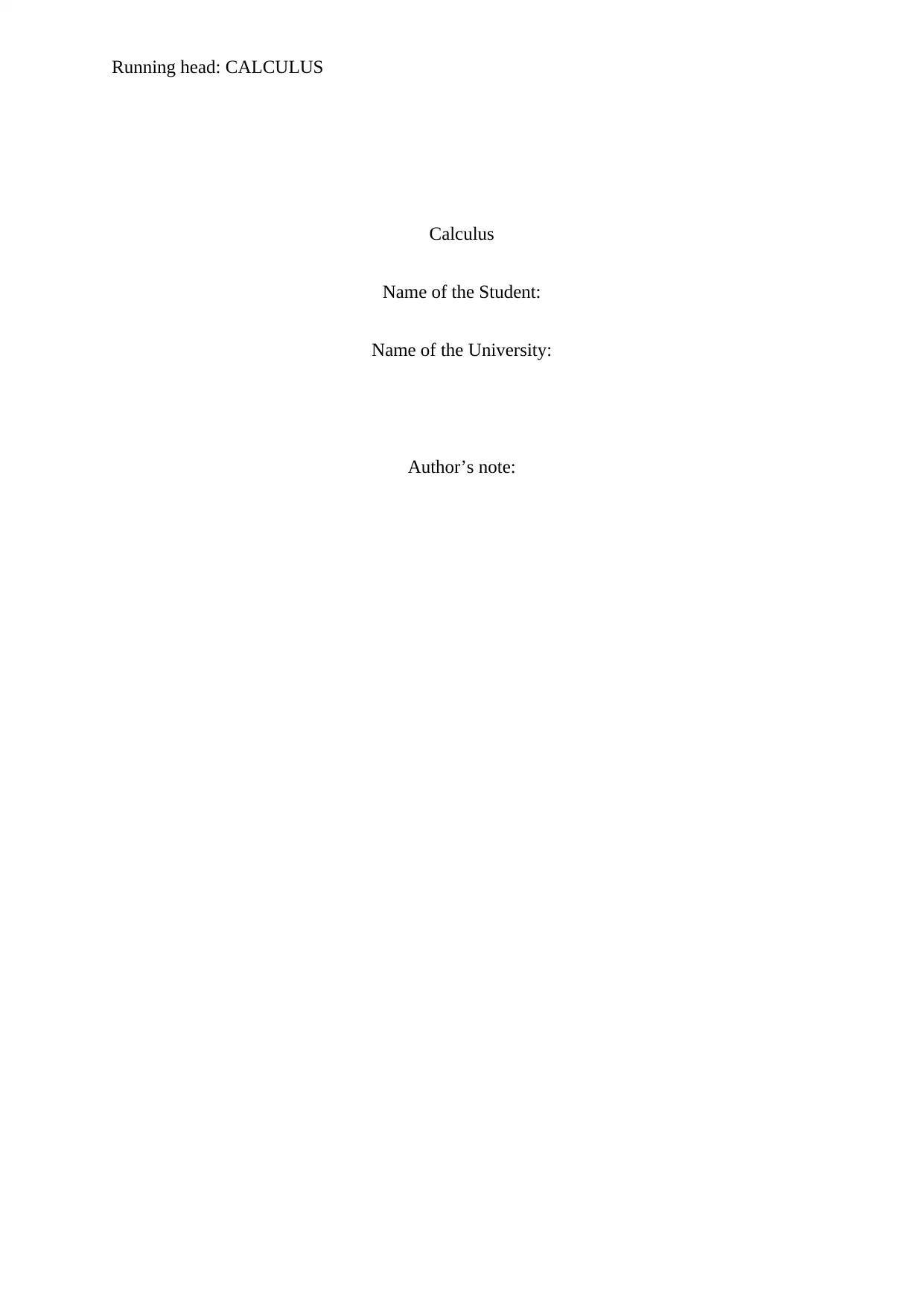
Running head: CALCULUS
Calculus
Name of the Student:
Name of the University:
Author’s note:
Calculus
Name of the Student:
Name of the University:
Author’s note:
Paraphrase This Document
Need a fresh take? Get an instant paraphrase of this document with our AI Paraphraser
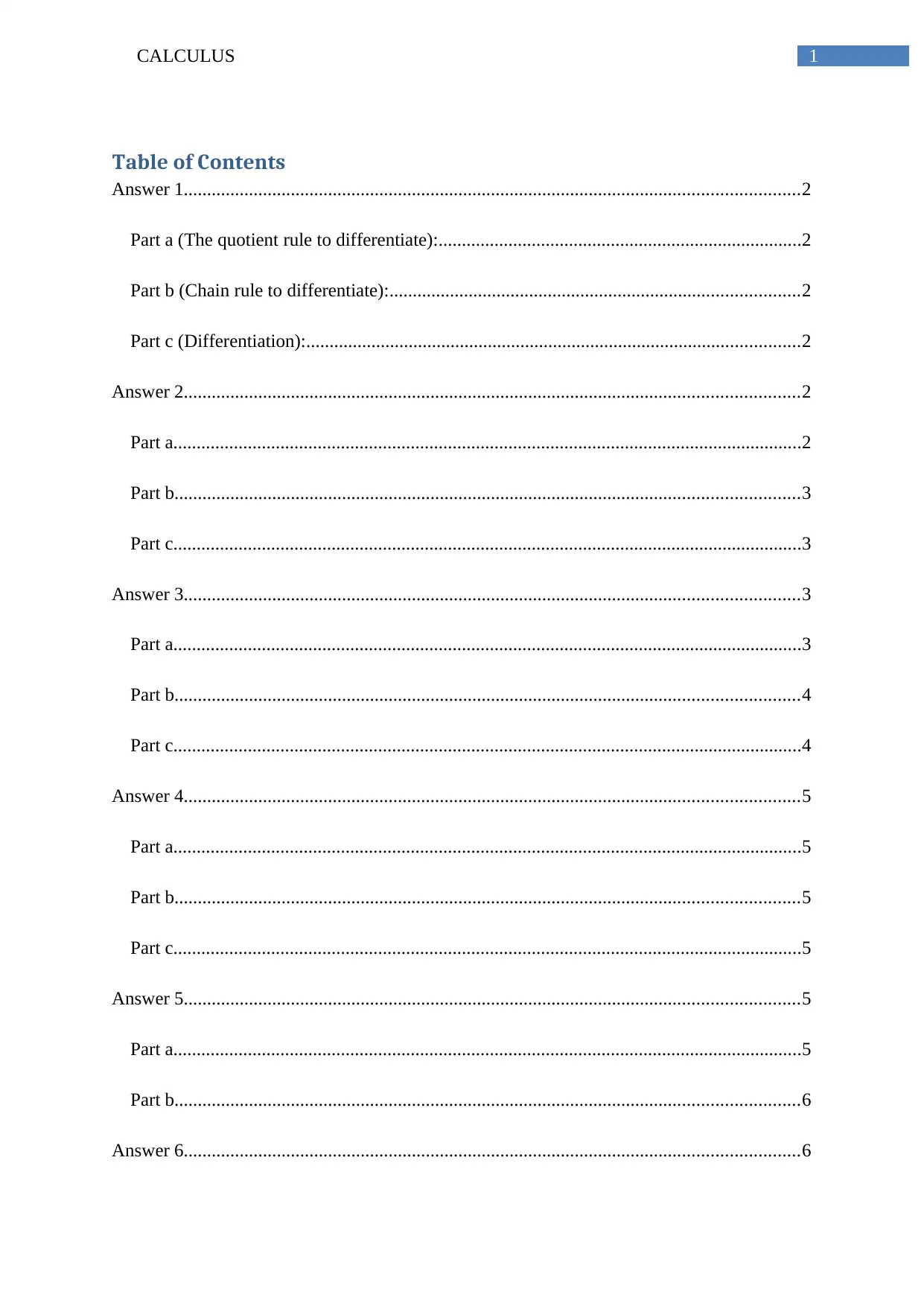
1CALCULUS
Table of Contents
Answer 1....................................................................................................................................2
Part a (The quotient rule to differentiate):..............................................................................2
Part b (Chain rule to differentiate):........................................................................................2
Part c (Differentiation):..........................................................................................................2
Answer 2....................................................................................................................................2
Part a.......................................................................................................................................2
Part b......................................................................................................................................3
Part c.......................................................................................................................................3
Answer 3....................................................................................................................................3
Part a.......................................................................................................................................3
Part b......................................................................................................................................4
Part c.......................................................................................................................................4
Answer 4....................................................................................................................................5
Part a.......................................................................................................................................5
Part b......................................................................................................................................5
Part c.......................................................................................................................................5
Answer 5....................................................................................................................................5
Part a.......................................................................................................................................5
Part b......................................................................................................................................6
Answer 6....................................................................................................................................6
Table of Contents
Answer 1....................................................................................................................................2
Part a (The quotient rule to differentiate):..............................................................................2
Part b (Chain rule to differentiate):........................................................................................2
Part c (Differentiation):..........................................................................................................2
Answer 2....................................................................................................................................2
Part a.......................................................................................................................................2
Part b......................................................................................................................................3
Part c.......................................................................................................................................3
Answer 3....................................................................................................................................3
Part a.......................................................................................................................................3
Part b......................................................................................................................................4
Part c.......................................................................................................................................4
Answer 4....................................................................................................................................5
Part a.......................................................................................................................................5
Part b......................................................................................................................................5
Part c.......................................................................................................................................5
Answer 5....................................................................................................................................5
Part a.......................................................................................................................................5
Part b......................................................................................................................................6
Answer 6....................................................................................................................................6
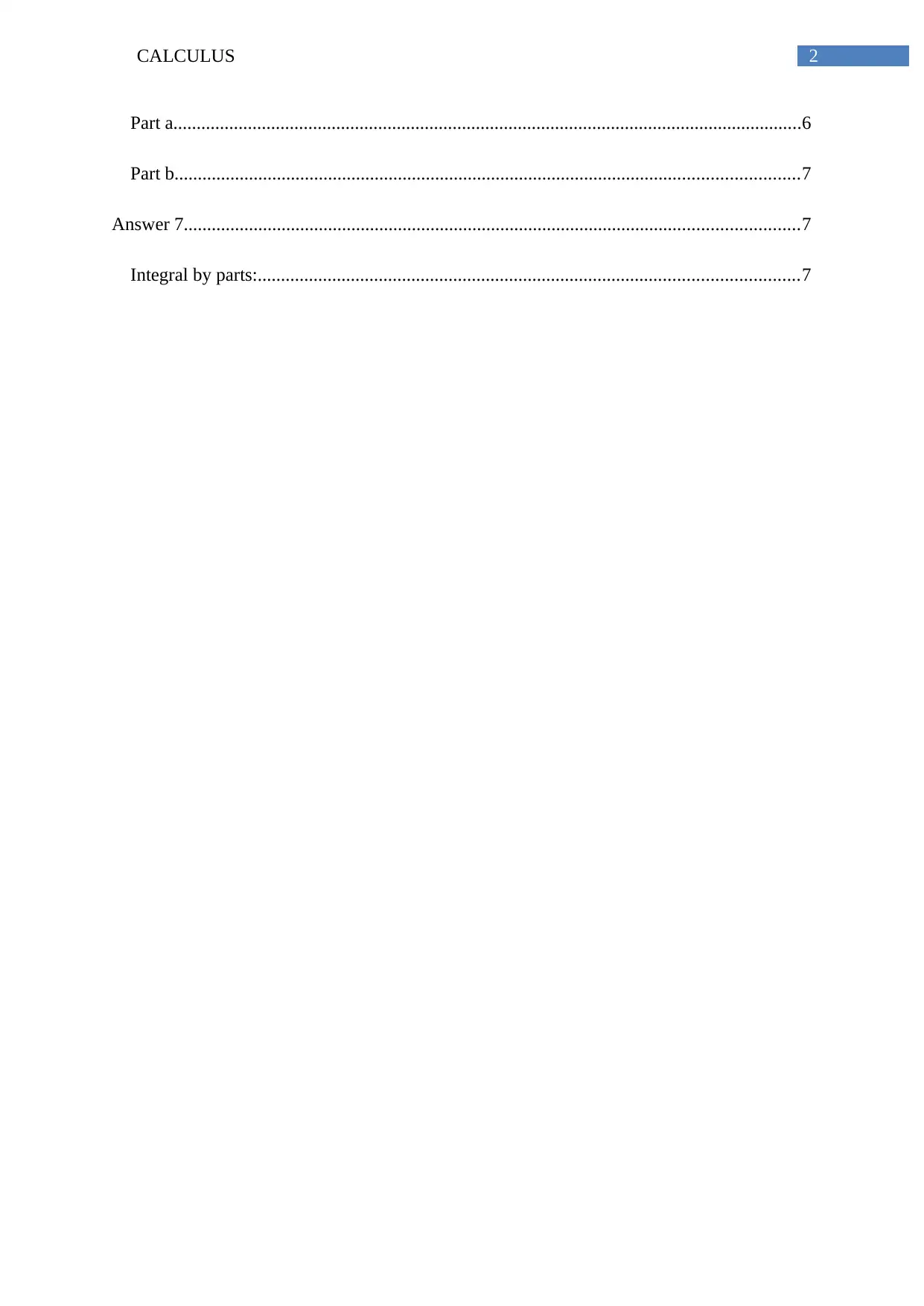
2CALCULUS
Part a.......................................................................................................................................6
Part b......................................................................................................................................7
Answer 7....................................................................................................................................7
Integral by parts:....................................................................................................................7
Part a.......................................................................................................................................6
Part b......................................................................................................................................7
Answer 7....................................................................................................................................7
Integral by parts:....................................................................................................................7
⊘ This is a preview!⊘
Do you want full access?
Subscribe today to unlock all pages.

Trusted by 1+ million students worldwide
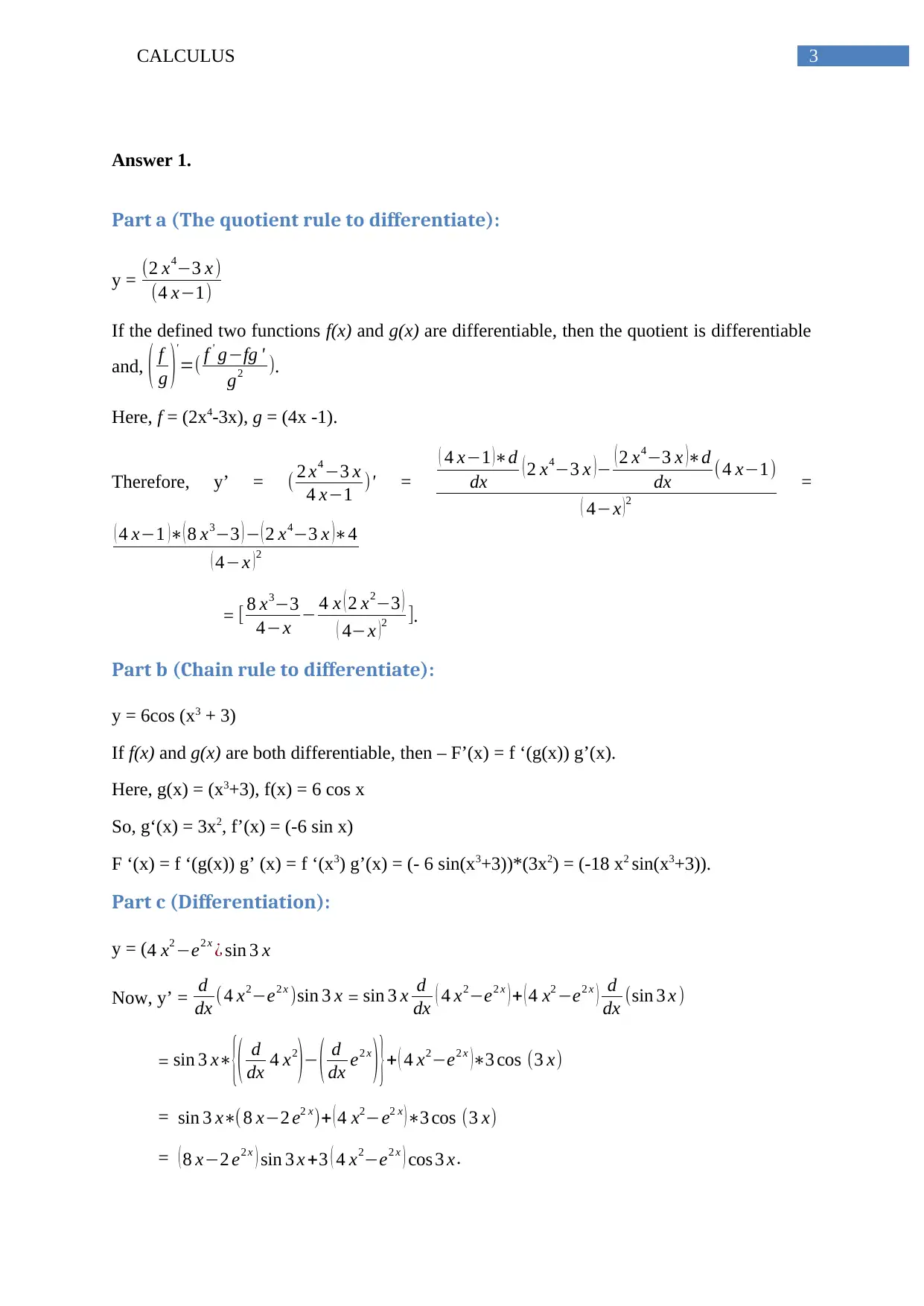
3CALCULUS
Answer 1.
Part a (The quotient rule to differentiate):
y = (2 x4−3 x )
(4 x−1)
If the defined two functions f(x) and g(x) are differentiable, then the quotient is differentiable
and, ( f
g )'
=( f ' g−fg '
g2 ).
Here, f = (2x4-3x), g = (4x -1).
Therefore, y’ = ( 2 x4 −3 x
4 x−1 )' =
( 4 x−1 )∗d
dx ( 2 x4−3 x )− ( 2 x4−3 x )∗d
dx (4 x−1)
( 4−x )2
=
( 4 x−1 )∗( 8 x3−3 ) − ( 2 x4−3 x )∗4
( 4−x ) 2
= [ 8 x3−3
4−x − 4 x ( 2 x2−3 )
( 4−x )2 ].
Part b (Chain rule to differentiate):
y = 6cos (x3 + 3)
If f(x) and g(x) are both differentiable, then – F’(x) = f ‘(g(x)) g’(x).
Here, g(x) = (x3+3), f(x) = 6 cos x
So, g‘(x) = 3x2, f’(x) = (-6 sin x)
F ‘(x) = f ‘(g(x)) g’ (x) = f ‘(x3) g’(x) = (- 6 sin(x3+3))*(3x2) = (-18 x2 sin(x3+3)).
Part c (Differentiation):
y = ( 4 x2 −e2 x ¿ sin 3 x
Now, y’ = d
dx (4 x2−e2 x )sin 3 x = sin 3 x d
dx ( 4 x2−e2 x ) + ( 4 x2 −e2 x ) d
dx (sin 3 x )
= sin 3 x∗
{( d
dx 4 x2
)− ( d
dx e2 x
) }+ ( 4 x2−e2 x )∗3 cos (3 x)
= sin 3 x∗( 8 x−2 e2 x)+ ( 4 x2−e2 x ) ∗3 cos (3 x)
= ( 8 x−2 e2 x ) sin 3 x +3 ( 4 x2−e2 x ) cos 3 x.
Answer 1.
Part a (The quotient rule to differentiate):
y = (2 x4−3 x )
(4 x−1)
If the defined two functions f(x) and g(x) are differentiable, then the quotient is differentiable
and, ( f
g )'
=( f ' g−fg '
g2 ).
Here, f = (2x4-3x), g = (4x -1).
Therefore, y’ = ( 2 x4 −3 x
4 x−1 )' =
( 4 x−1 )∗d
dx ( 2 x4−3 x )− ( 2 x4−3 x )∗d
dx (4 x−1)
( 4−x )2
=
( 4 x−1 )∗( 8 x3−3 ) − ( 2 x4−3 x )∗4
( 4−x ) 2
= [ 8 x3−3
4−x − 4 x ( 2 x2−3 )
( 4−x )2 ].
Part b (Chain rule to differentiate):
y = 6cos (x3 + 3)
If f(x) and g(x) are both differentiable, then – F’(x) = f ‘(g(x)) g’(x).
Here, g(x) = (x3+3), f(x) = 6 cos x
So, g‘(x) = 3x2, f’(x) = (-6 sin x)
F ‘(x) = f ‘(g(x)) g’ (x) = f ‘(x3) g’(x) = (- 6 sin(x3+3))*(3x2) = (-18 x2 sin(x3+3)).
Part c (Differentiation):
y = ( 4 x2 −e2 x ¿ sin 3 x
Now, y’ = d
dx (4 x2−e2 x )sin 3 x = sin 3 x d
dx ( 4 x2−e2 x ) + ( 4 x2 −e2 x ) d
dx (sin 3 x )
= sin 3 x∗
{( d
dx 4 x2
)− ( d
dx e2 x
) }+ ( 4 x2−e2 x )∗3 cos (3 x)
= sin 3 x∗( 8 x−2 e2 x)+ ( 4 x2−e2 x ) ∗3 cos (3 x)
= ( 8 x−2 e2 x ) sin 3 x +3 ( 4 x2−e2 x ) cos 3 x.
Paraphrase This Document
Need a fresh take? Get an instant paraphrase of this document with our AI Paraphraser
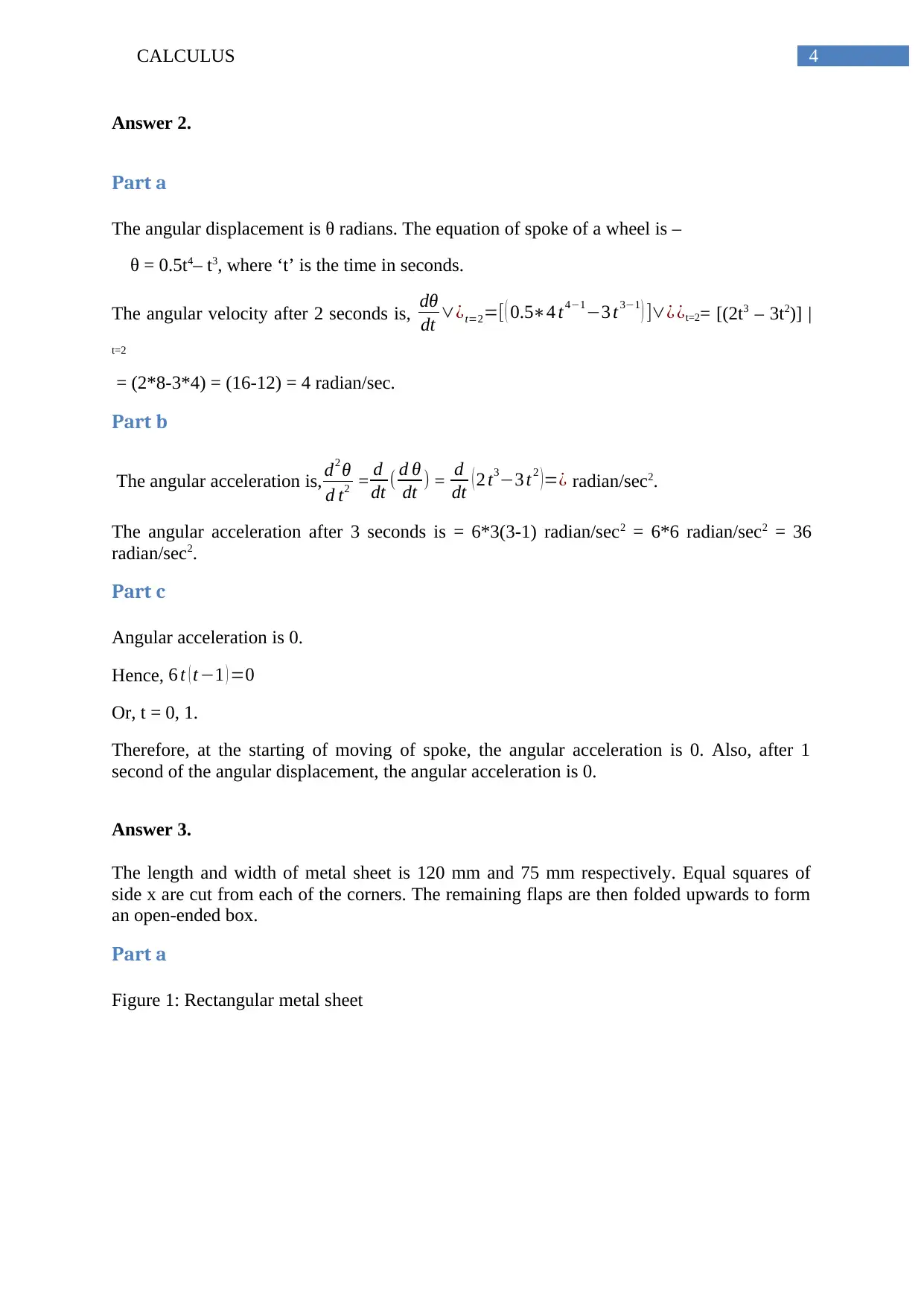
4CALCULUS
Answer 2.
Part a
The angular displacement is θ radians. The equation of spoke of a wheel is –
θ = 0.5t4– t3, where ‘t’ is the time in seconds.
The angular velocity after 2 seconds is, dθ
dt ∨¿t=2=[ ( 0.5∗4 t4−1−3 t3−1 ) ]∨¿ ¿t=2= [(2t3 – 3t2)] |
t=2
= (2*8-3*4) = (16-12) = 4 radian/sec.
Part b
The angular acceleration is, d2 θ
d t2 = d
dt ( d θ
dt ) = d
dt ( 2 t3−3 t2 ) =¿ radian/sec2.
The angular acceleration after 3 seconds is = 6*3(3-1) radian/sec2 = 6*6 radian/sec2 = 36
radian/sec2.
Part c
Angular acceleration is 0.
Hence, 6 t ( t−1 ) =0
Or, t = 0, 1.
Therefore, at the starting of moving of spoke, the angular acceleration is 0. Also, after 1
second of the angular displacement, the angular acceleration is 0.
Answer 3.
The length and width of metal sheet is 120 mm and 75 mm respectively. Equal squares of
side x are cut from each of the corners. The remaining flaps are then folded upwards to form
an open-ended box.
Part a
Figure 1: Rectangular metal sheet
Answer 2.
Part a
The angular displacement is θ radians. The equation of spoke of a wheel is –
θ = 0.5t4– t3, where ‘t’ is the time in seconds.
The angular velocity after 2 seconds is, dθ
dt ∨¿t=2=[ ( 0.5∗4 t4−1−3 t3−1 ) ]∨¿ ¿t=2= [(2t3 – 3t2)] |
t=2
= (2*8-3*4) = (16-12) = 4 radian/sec.
Part b
The angular acceleration is, d2 θ
d t2 = d
dt ( d θ
dt ) = d
dt ( 2 t3−3 t2 ) =¿ radian/sec2.
The angular acceleration after 3 seconds is = 6*3(3-1) radian/sec2 = 6*6 radian/sec2 = 36
radian/sec2.
Part c
Angular acceleration is 0.
Hence, 6 t ( t−1 ) =0
Or, t = 0, 1.
Therefore, at the starting of moving of spoke, the angular acceleration is 0. Also, after 1
second of the angular displacement, the angular acceleration is 0.
Answer 3.
The length and width of metal sheet is 120 mm and 75 mm respectively. Equal squares of
side x are cut from each of the corners. The remaining flaps are then folded upwards to form
an open-ended box.
Part a
Figure 1: Rectangular metal sheet

5CALCULUS
120 mm
x mm x mm
1st square 2nd square
First Flip
x mm x mm
75 mm Fourth Second
Flip Base of the box Flip
x mm x mm
Third Flip
3rd square 4th square
x mm x mm
Part b
The length of the base of the box will be (120-x-x) mm = (120-2x) mm.
The width of the base of the box will be (75-x-x) mm = (75-2x) mm.
The height of the box = x mm.
120 mm
x mm x mm
1st square 2nd square
First Flip
x mm x mm
75 mm Fourth Second
Flip Base of the box Flip
x mm x mm
Third Flip
3rd square 4th square
x mm x mm
Part b
The length of the base of the box will be (120-x-x) mm = (120-2x) mm.
The width of the base of the box will be (75-x-x) mm = (75-2x) mm.
The height of the box = x mm.
⊘ This is a preview!⊘
Do you want full access?
Subscribe today to unlock all pages.

Trusted by 1+ million students worldwide
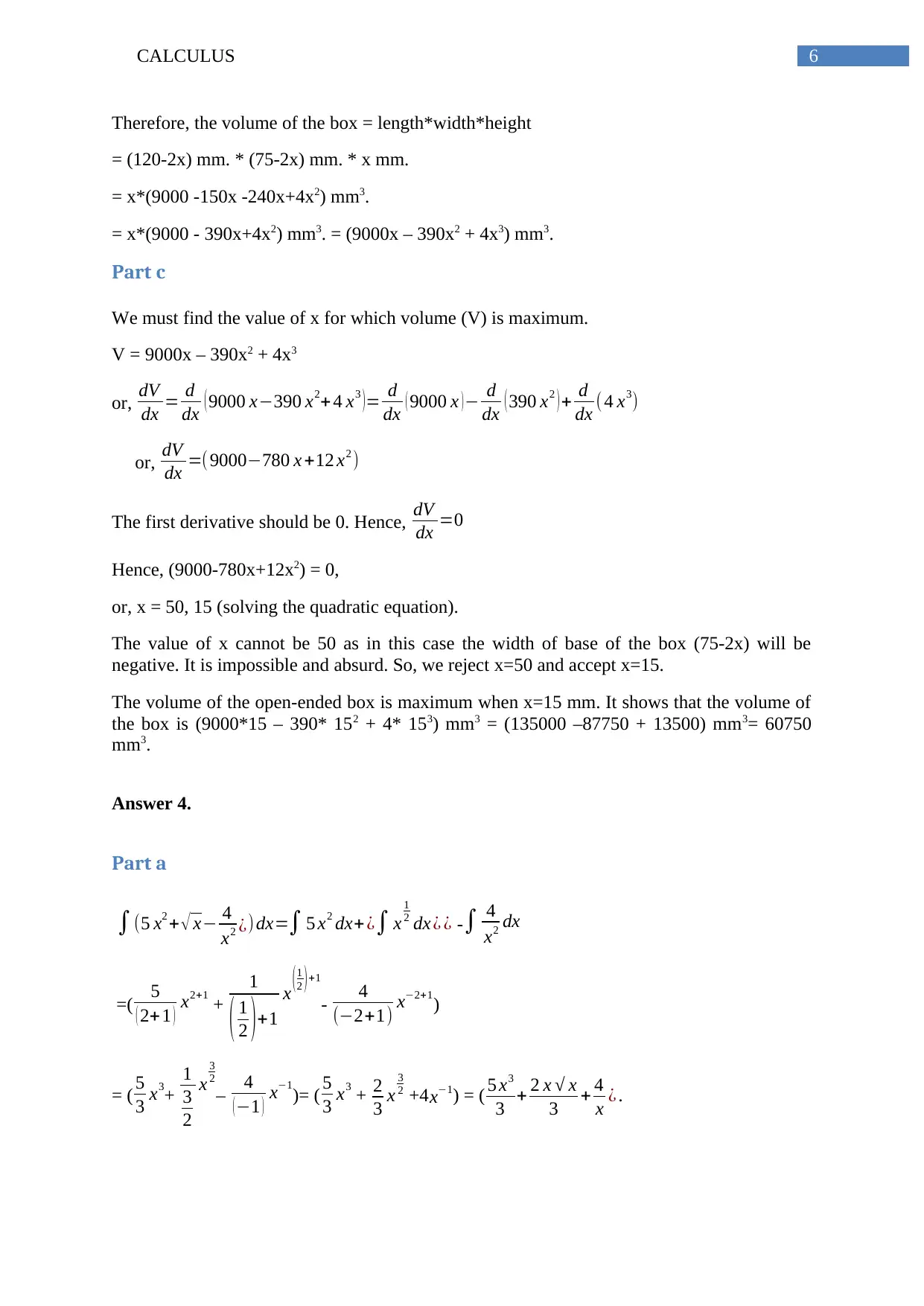
6CALCULUS
Therefore, the volume of the box = length*width*height
= (120-2x) mm. * (75-2x) mm. * x mm.
= x*(9000 -150x -240x+4x2) mm3.
= x*(9000 - 390x+4x2) mm3. = (9000x – 390x2 + 4x3) mm3.
Part c
We must find the value of x for which volume (V) is maximum.
V = 9000x – 390x2 + 4x3
or, dV
dx = d
dx ( 9000 x−390 x2+4 x3 )= d
dx ( 9000 x )− d
dx ( 390 x2 ) + d
dx ( 4 x3)
or, dV
dx =( 9000−780 x +12 x2 )
The first derivative should be 0. Hence, dV
dx =0
Hence, (9000-780x+12x2) = 0,
or, x = 50, 15 (solving the quadratic equation).
The value of x cannot be 50 as in this case the width of base of the box (75-2x) will be
negative. It is impossible and absurd. So, we reject x=50 and accept x=15.
The volume of the open-ended box is maximum when x=15 mm. It shows that the volume of
the box is (9000*15 – 390* 152 + 4* 153) mm3 = (135000 –87750 + 13500) mm3= 60750
mm3.
Answer 4.
Part a
∫(5 x2 + √ x− 4
x2 ¿) dx=∫ 5 x2 dx+¿∫ x
1
2 dx ¿ ¿ -∫ 4
x2 dx
=( 5
( 2+ 1 ) x2+1
+
1
( 1
2 )+1
x (1
2 )+1
- 4
(−2+1) x−2+1
)
= ( 5
3 x3+
1
3
2
x
3
2
– 4
( −1 ) x−1
)= ( 5
3 x3 + 2
3 x
3
2 +4x−1) = ( 5 x3
3 + 2 x √ x
3 + 4
x ¿ .
Therefore, the volume of the box = length*width*height
= (120-2x) mm. * (75-2x) mm. * x mm.
= x*(9000 -150x -240x+4x2) mm3.
= x*(9000 - 390x+4x2) mm3. = (9000x – 390x2 + 4x3) mm3.
Part c
We must find the value of x for which volume (V) is maximum.
V = 9000x – 390x2 + 4x3
or, dV
dx = d
dx ( 9000 x−390 x2+4 x3 )= d
dx ( 9000 x )− d
dx ( 390 x2 ) + d
dx ( 4 x3)
or, dV
dx =( 9000−780 x +12 x2 )
The first derivative should be 0. Hence, dV
dx =0
Hence, (9000-780x+12x2) = 0,
or, x = 50, 15 (solving the quadratic equation).
The value of x cannot be 50 as in this case the width of base of the box (75-2x) will be
negative. It is impossible and absurd. So, we reject x=50 and accept x=15.
The volume of the open-ended box is maximum when x=15 mm. It shows that the volume of
the box is (9000*15 – 390* 152 + 4* 153) mm3 = (135000 –87750 + 13500) mm3= 60750
mm3.
Answer 4.
Part a
∫(5 x2 + √ x− 4
x2 ¿) dx=∫ 5 x2 dx+¿∫ x
1
2 dx ¿ ¿ -∫ 4
x2 dx
=( 5
( 2+ 1 ) x2+1
+
1
( 1
2 )+1
x (1
2 )+1
- 4
(−2+1) x−2+1
)
= ( 5
3 x3+
1
3
2
x
3
2
– 4
( −1 ) x−1
)= ( 5
3 x3 + 2
3 x
3
2 +4x−1) = ( 5 x3
3 + 2 x √ x
3 + 4
x ¿ .
Paraphrase This Document
Need a fresh take? Get an instant paraphrase of this document with our AI Paraphraser
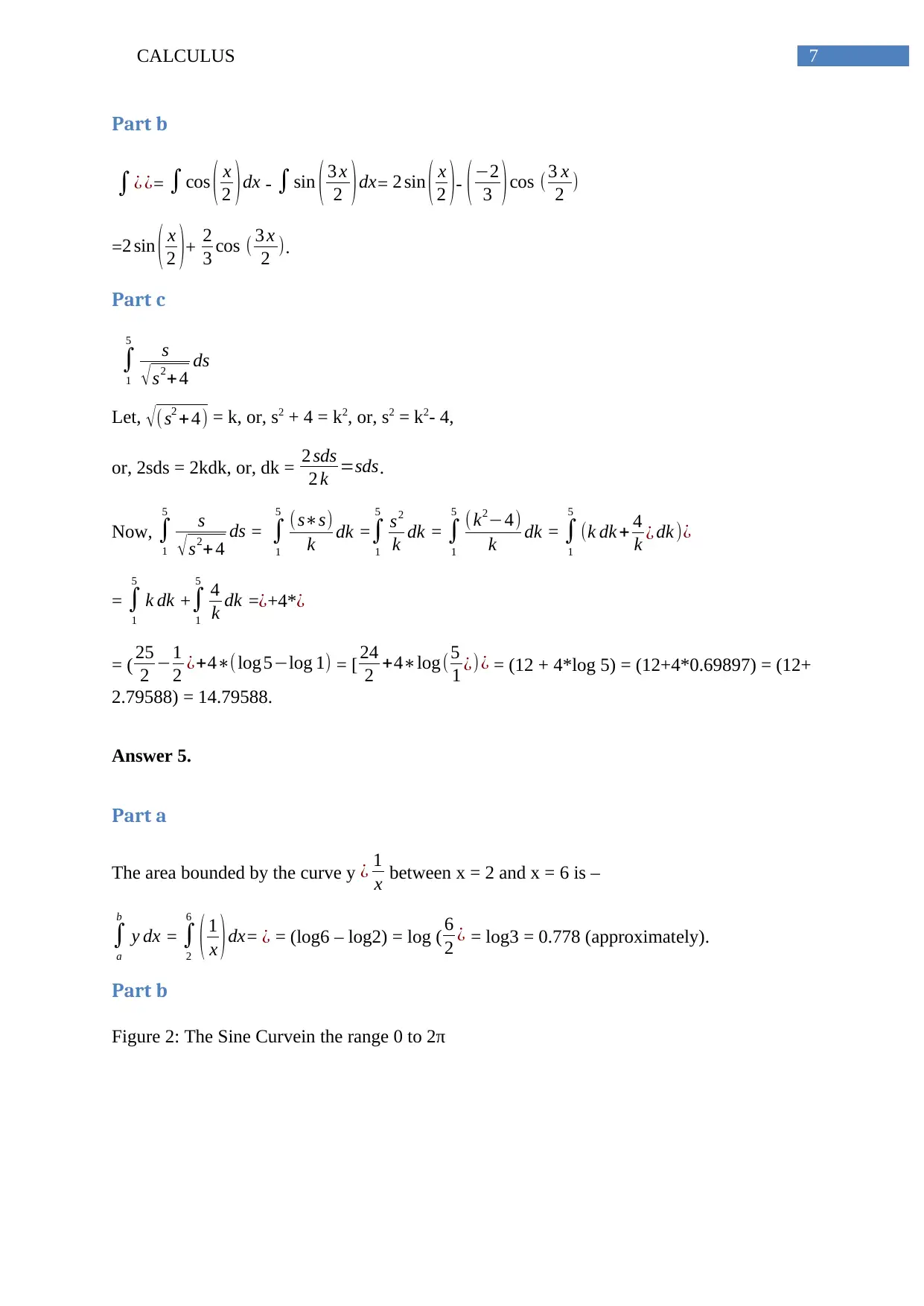
7CALCULUS
Part b
∫¿ ¿= ∫cos ( x
2 )dx - ∫sin ( 3 x
2 )dx= 2 sin ( x
2 )- (−2
3 )cos (3 x
2 )
=2 sin ( x
2 )+ 2
3 cos ( 3 x
2 ).
Part c
∫
1
5
s
√ s2+ 4 ds
Let, √ (s2 +4) = k, or, s2 + 4 = k2, or, s2 = k2- 4,
or, 2sds = 2kdk, or, dk = 2 sds
2 k =sds.
Now, ∫
1
5
s
√ s2+ 4 ds = ∫
1
5 ( s∗s)
k dk =∫
1
5
s2
k dk = ∫
1
5 ( k2−4)
k dk = ∫
1
5
(k dk + 4
k ¿ dk )¿
= ∫
1
5
k dk +∫
1
5
4
k dk =¿+4*¿
= ( 25
2 −1
2 ¿+4∗(log5−log 1) = [ 24
2 +4∗log(5
1 ¿)¿ = (12 + 4*log 5) = (12+4*0.69897) = (12+
2.79588) = 14.79588.
Answer 5.
Part a
The area bounded by the curve y ¿ 1
x between x = 2 and x = 6 is –
∫
a
b
y dx = ∫
2
6
( 1
x ) dx= ¿ = (log6 – log2) = log ( 6
2 ¿ = log3 = 0.778 (approximately).
Part b
Figure 2: The Sine Curvein the range 0 to 2π
Part b
∫¿ ¿= ∫cos ( x
2 )dx - ∫sin ( 3 x
2 )dx= 2 sin ( x
2 )- (−2
3 )cos (3 x
2 )
=2 sin ( x
2 )+ 2
3 cos ( 3 x
2 ).
Part c
∫
1
5
s
√ s2+ 4 ds
Let, √ (s2 +4) = k, or, s2 + 4 = k2, or, s2 = k2- 4,
or, 2sds = 2kdk, or, dk = 2 sds
2 k =sds.
Now, ∫
1
5
s
√ s2+ 4 ds = ∫
1
5 ( s∗s)
k dk =∫
1
5
s2
k dk = ∫
1
5 ( k2−4)
k dk = ∫
1
5
(k dk + 4
k ¿ dk )¿
= ∫
1
5
k dk +∫
1
5
4
k dk =¿+4*¿
= ( 25
2 −1
2 ¿+4∗(log5−log 1) = [ 24
2 +4∗log(5
1 ¿)¿ = (12 + 4*log 5) = (12+4*0.69897) = (12+
2.79588) = 14.79588.
Answer 5.
Part a
The area bounded by the curve y ¿ 1
x between x = 2 and x = 6 is –
∫
a
b
y dx = ∫
2
6
( 1
x ) dx= ¿ = (log6 – log2) = log ( 6
2 ¿ = log3 = 0.778 (approximately).
Part b
Figure 2: The Sine Curvein the range 0 to 2π
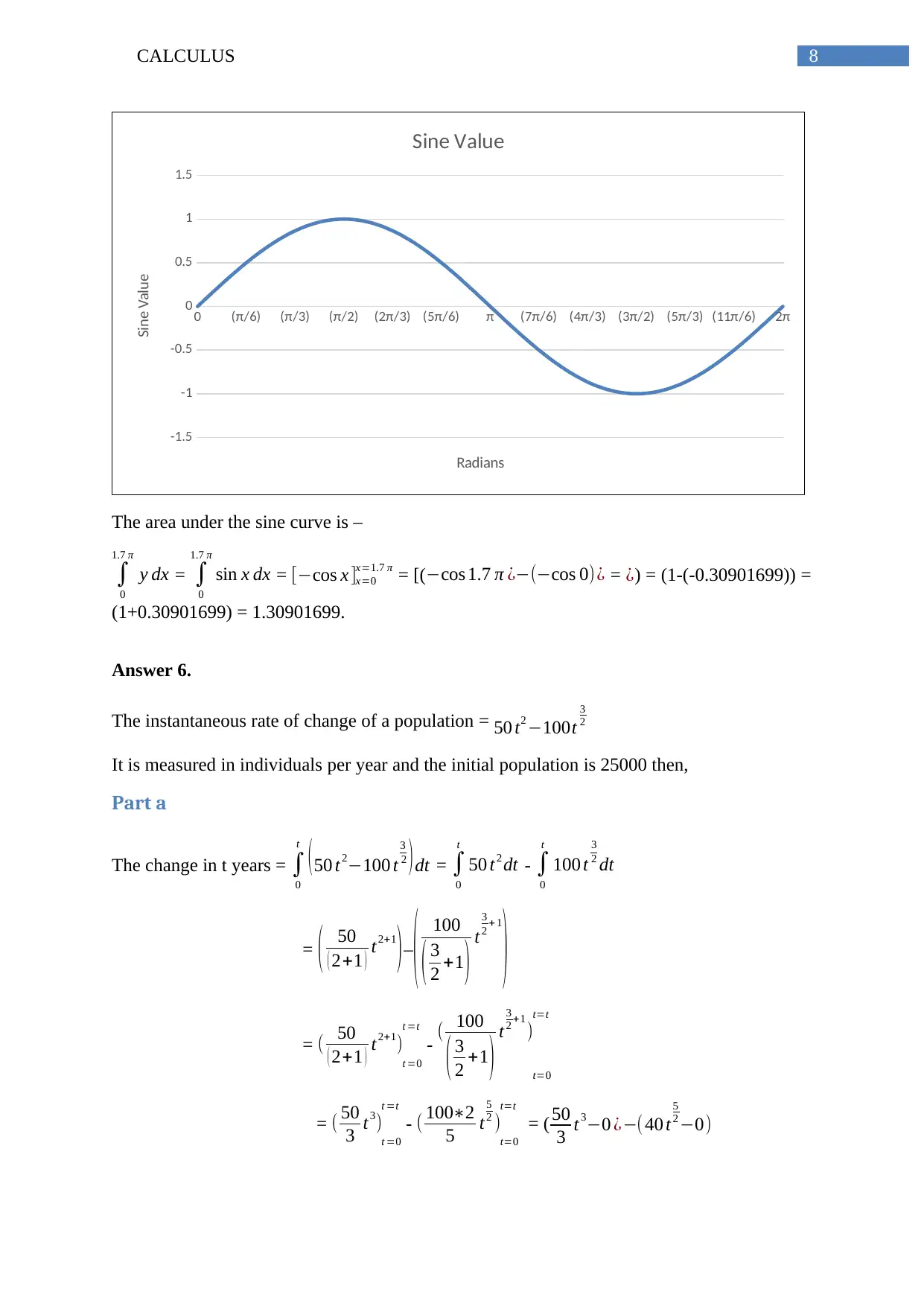
8CALCULUS
0 (π/6) (π/3) (π/2) (2π/3) (5π/6) π (7π/6) (4π/3) (3π/2) (5π/3) (11π/6) 2π
-1.5
-1
-0.5
0
0.5
1
1.5
Sine Value
Radians
Sine Value
The area under the sine curve is –
∫
0
1.7 π
y dx = ∫
0
1.7 π
sin x dx = [−cos x ]x=0
x=1.7 π = [(−cos 1.7 π ¿−(−cos 0)¿ = ¿) = (1-(-0.30901699)) =
(1+0.30901699) = 1.30901699.
Answer 6.
The instantaneous rate of change of a population = 50 t2 −100t
3
2
It is measured in individuals per year and the initial population is 25000 then,
Part a
The change in t years = ∫
0
t
(50 t2−100 t
3
2 )dt = ∫
0
t
50 t2 dt - ∫
0
t
100 t
3
2 dt
= ( 50
( 2+1 ) t2+1
)–
( 100
( 3
2 +1 ) t
3
2 + 1
)
= ( 50
( 2+1 ) t2+1)t =0
t =t
- ( 100
( 3
2 +1 ) t
3
2 +1
)
t=0
t=t
= ( 50
3 t3)t =0
t =t
- ( 100∗2
5 t
5
2 )t=0
t=t
= ( 50
3 t3−0 ¿−( 40 t
5
2 −0)
0 (π/6) (π/3) (π/2) (2π/3) (5π/6) π (7π/6) (4π/3) (3π/2) (5π/3) (11π/6) 2π
-1.5
-1
-0.5
0
0.5
1
1.5
Sine Value
Radians
Sine Value
The area under the sine curve is –
∫
0
1.7 π
y dx = ∫
0
1.7 π
sin x dx = [−cos x ]x=0
x=1.7 π = [(−cos 1.7 π ¿−(−cos 0)¿ = ¿) = (1-(-0.30901699)) =
(1+0.30901699) = 1.30901699.
Answer 6.
The instantaneous rate of change of a population = 50 t2 −100t
3
2
It is measured in individuals per year and the initial population is 25000 then,
Part a
The change in t years = ∫
0
t
(50 t2−100 t
3
2 )dt = ∫
0
t
50 t2 dt - ∫
0
t
100 t
3
2 dt
= ( 50
( 2+1 ) t2+1
)–
( 100
( 3
2 +1 ) t
3
2 + 1
)
= ( 50
( 2+1 ) t2+1)t =0
t =t
- ( 100
( 3
2 +1 ) t
3
2 +1
)
t=0
t=t
= ( 50
3 t3)t =0
t =t
- ( 100∗2
5 t
5
2 )t=0
t=t
= ( 50
3 t3−0 ¿−( 40 t
5
2 −0)
⊘ This is a preview!⊘
Do you want full access?
Subscribe today to unlock all pages.

Trusted by 1+ million students worldwide
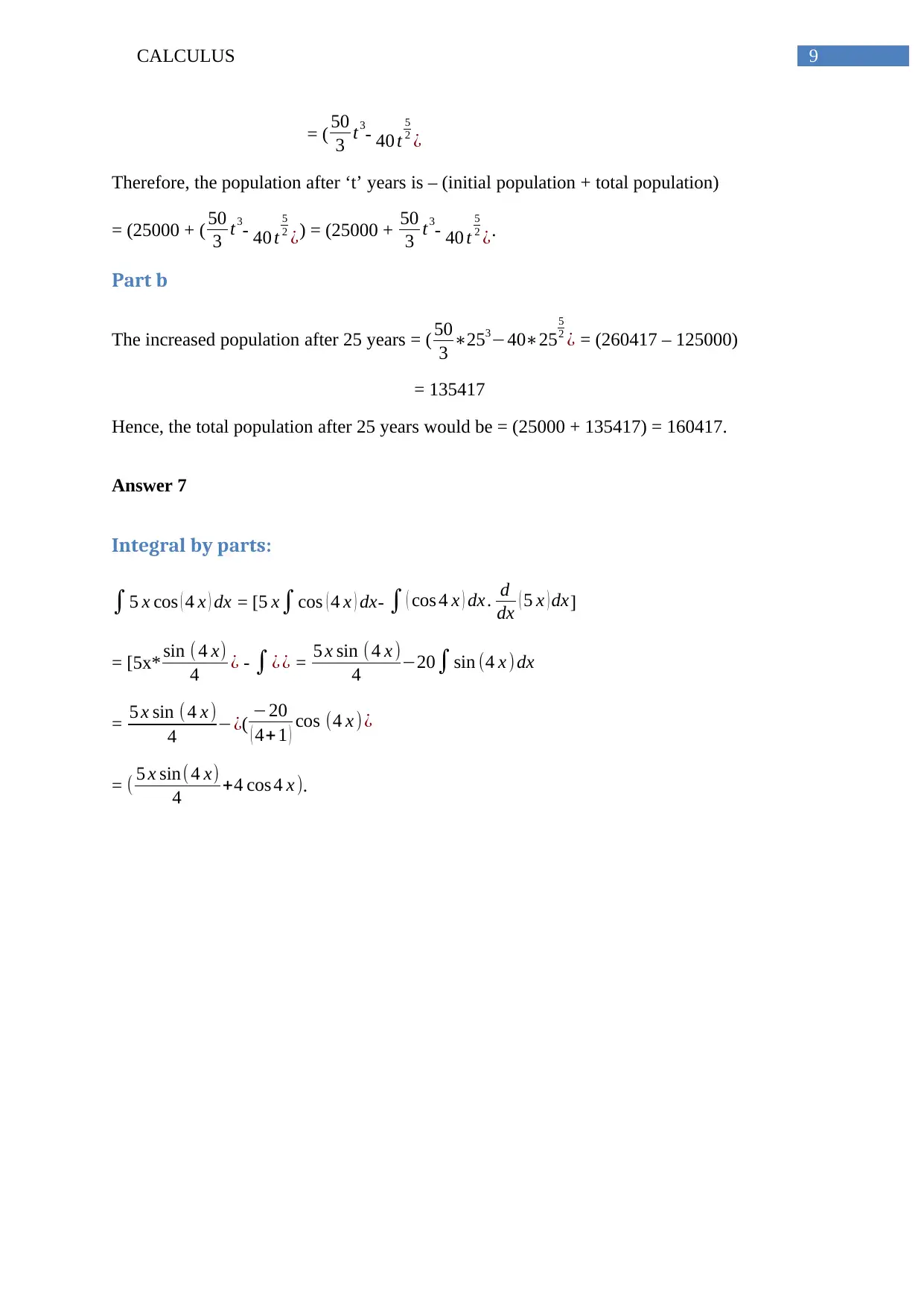
9CALCULUS
= ( 50
3 t3- 40 t
5
2 ¿
Therefore, the population after ‘t’ years is – (initial population + total population)
= (25000 + ( 50
3 t3
- 40 t
5
2 ¿) = (25000 + 50
3 t3
- 40 t
5
2 ¿.
Part b
The increased population after 25 years = ( 50
3 ∗253−40∗25
5
2 ¿ = (260417 – 125000)
= 135417
Hence, the total population after 25 years would be = (25000 + 135417) = 160417.
Answer 7
Integral by parts:
∫5 x cos ( 4 x ) dx = [5 x∫cos ( 4 x ) dx- ∫ ( cos 4 x ) dx . d
dx ( 5 x ) dx]
= [5x* sin ( 4 x)
4 ¿ - ∫¿ ¿ = 5 x sin (4 x )
4 −20∫sin (4 x ) dx
= 5 x sin ( 4 x )
4 −¿( −20
( 4+ 1 ) cos (4 x ) ¿
= ( 5 x sin( 4 x)
4 +4 cos 4 x ).
= ( 50
3 t3- 40 t
5
2 ¿
Therefore, the population after ‘t’ years is – (initial population + total population)
= (25000 + ( 50
3 t3
- 40 t
5
2 ¿) = (25000 + 50
3 t3
- 40 t
5
2 ¿.
Part b
The increased population after 25 years = ( 50
3 ∗253−40∗25
5
2 ¿ = (260417 – 125000)
= 135417
Hence, the total population after 25 years would be = (25000 + 135417) = 160417.
Answer 7
Integral by parts:
∫5 x cos ( 4 x ) dx = [5 x∫cos ( 4 x ) dx- ∫ ( cos 4 x ) dx . d
dx ( 5 x ) dx]
= [5x* sin ( 4 x)
4 ¿ - ∫¿ ¿ = 5 x sin (4 x )
4 −20∫sin (4 x ) dx
= 5 x sin ( 4 x )
4 −¿( −20
( 4+ 1 ) cos (4 x ) ¿
= ( 5 x sin( 4 x)
4 +4 cos 4 x ).
1 out of 10
Related Documents
Your All-in-One AI-Powered Toolkit for Academic Success.
+13062052269
info@desklib.com
Available 24*7 on WhatsApp / Email
![[object Object]](/_next/static/media/star-bottom.7253800d.svg)
Unlock your academic potential
Copyright © 2020–2025 A2Z Services. All Rights Reserved. Developed and managed by ZUCOL.




